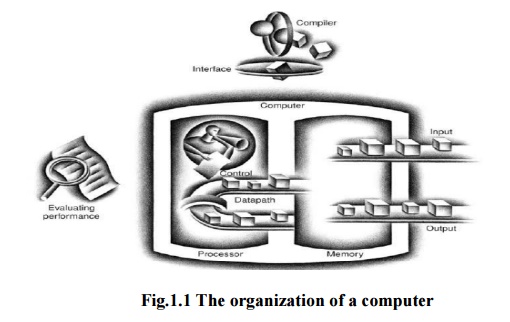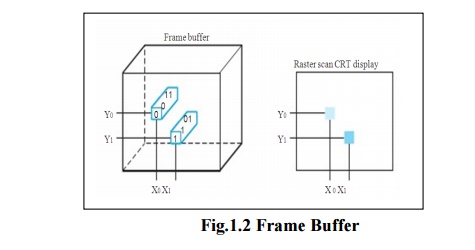Chapter: Computer Architecture : Overview & Instructions
Components of a Computer System
COMPONENTS OF A COMPUTER SYSTEM
The five classic components of a
computer are input, output, memory, datapath, and control. Datapath and control
are combined and called as the processor. The figure 1.1 shows the standard
organization of a computer. This organization is independent of hardware
technology.
The
organization of a computer, showing the five classic components.
1. Input
writes data to memory
2. Output
reads data from memory
3. Memory
stores data and programs
4. Control
sends the signals that determine the operations of the datapath, memory, input,
and output.
5. Datapath
performs arithmetic and logic operations

Fig.1.1
The organization of a computer
Two key components of computers:
1. Input
devices, such as the keyboard and mouse,
2. Output
devices, such as the screen.
·
Input device - A mechanism through which the
computer is fed information, such as the keyboard or mouse.
·
Output device - A mechanism that conveys the
result of a computation to a user or another computer.
As the names suggest, input feeds
the computer, and output is the result of computation sent to the user. Some
devices, such as networks and disks, provide both input and output to the
computer.
Input Device
The most commonly used input
device is a keyboard. Whenever the user presses a key the control signal be
sent to the processor. The processor respond for that by displaying the
corresponding character on the display.
The next commonly used input
device is a mouse.The original mouse was electromechanical and used a large
ball. When it is rolled across a surface, it would cause an x and y counter to
be incremented. The amount of increase in each counter told how far the mouse
had been moved.
The electromechanical mouse has
been replaced by the optical mouse. The optical mouse is actually a miniature
optical processor including an LED to provide lighting, a tiny black-and-white
camera, and a simple optical processor. The LED illuminates the surface
underneath the mouse; the camera takes 1500 sample pictures a second under the
illumination. Successive pictures are sent to a simple optical processor that
compares the images and determines whether the mouse has moved and how far.
Output Device
The most fascinating I/O device
is probably the graphics display. Most personal mobile devices use liquid
crystal displays (LCDs) to get a thin, low-power display. The LCD is not the
source of light; instead, it controls the transmission of light. A typical LCD
includes rod-shaped molecules in a liquid that form a twisting helix that bends
light entering the display, from either a light source behind the display or
less often from reflected light.
Today, most LCD displays use an
active matrix that has a tiny transistor switch at each pixel to precisely
control current and make sharper images. As in a CRT, a red-green-blue mask
associated with each pixel determines the intensity of the three color
components in the final image; in a color active matrix
LCD, there are three transistor switches at each pixel.
The computer hardware supports a
refresh buffer, or frame buffer, to store the bit map. The image to be
represented on-screen is stored in the frame buffer, and the bit pattern per
pixel is read out to the graphics display at the refresh rate.
Pixel - The smallest individual
picture element. Screen are composed of hundreds of thousands to millions of
pixels, organized in a matrix.

Fig.1.2
Frame Buffer
Each coordinate in the frame
buffer on the left determines the shade of the corresponding coordinate for the
raster scan CRT display on the right. Pixel (X0, Y0) contains the bit pattern
0011, which is a lighter shade of gray on the screen than the bit pattern 1101
in pixel (X1, Y1).
Processor
Central processor unit (CPU) -
Also called processor. The active part of the computer, which contains the
datapath and control and which adds numbers, tests numbers, signals I/O devices
to activate, and so on. The processor gets instructions and data from memory.
·
Datapath - The component of the processor that
performs arithmetic operations.
·
Control - The component of the processor that
commands the datapath, memory, and I/O devices according to the instructions of
the program.
Memory
·
Memory The storage area in which programs are kept
when they are running and that contains the data needed by the running
programs.
·
Primary memory - Also called main memory. It is a
Volatile memory used to hold programs while they are running;
typically consists of DRAM in today’s computers.
·
Dynamic random access memory (DRAM) Memory built
as an integrated circuit, it provides random access to any locationSecondary
memory Non- volatile memory used to store programs and data between runs; typically
consists of magnetic disks in today’s computers.
·
Magnetic disk (also called hard disk) A form of
nonvolatile secondary memory composed of rotating platters coated with a
magnetic recording material.
·
Cache memory A small, fast memory that acts as a
buffer for a slower, larger memory. Cache is built using a different memory
technology, static random access memory (SRAM). SRAM is faster but less dense,
and hence more expensive, than DRAM.
·
Volatile memory Storage, such as DRAM, that only
retains data only if it is receiving power.
·
Nonvolatile memory A form of memory that retains
data even in the absence of a power source and that is used to store programs
between runs. Magnetic disk is nonvolatile and DRAM is not.
Removable storage technologies:
·
Optical disks, including both compact disks (CDs)
and digital video disks (DVDs), constitute the most common form of removable
storage.
·
Magnetic tape provides only slow serial access and
has been used to back up disks, in a role now often replaced by duplicate hard
drives.
·
FLASH-based removable memory cards typically
attach by a USB (Universal Serial Bus) connection and are often used to
transfer files.
·
Floppy drives and Zip drives are a version of
magnetic disk technology with removable flexible
disks. Floppy disks were the original primary storage for personal computers,
but
have
now largely vanished.
Related Topics